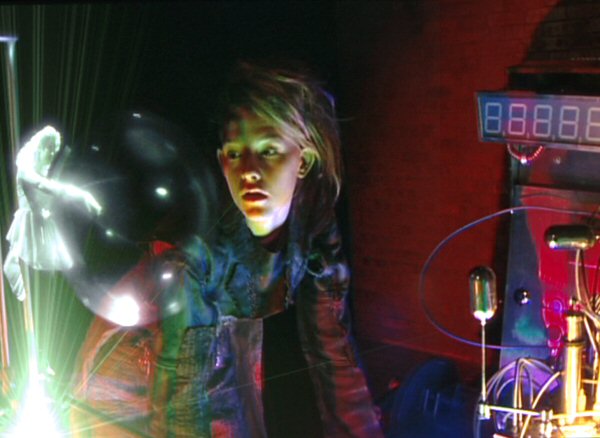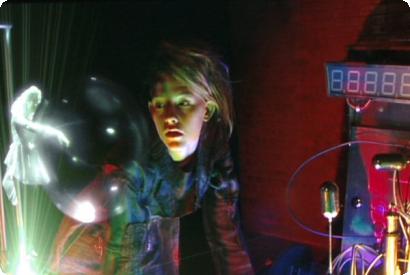Please wait a few moments while we process your request

Toni Dove
Spectropia: A Ghost Story on the Infinite Deferral of Desire
The Daniel Langlois Foundation has funded the development of Spectropia: A Ghost Story on the Infinite Deferral of Desire, the second part in a trilogy of narrative, interactive installations begun in 1998. The first part, Artificial Changelings, was performed for the public on numerous occasions in the United States and Europe. Co-produced by The Institute for Studies in the Arts (Tempe, Ariz., United States), the Banff Centre for the Arts (Banff, Alberta, Canada) and Thundergulch, Spectropia is a feature film including interactive components and created as a theatrical performance. A version of Spectropia is also planned for home use via a combination of DVD and Internet transfer. The film is part historical chronicle, part science fiction.
The story starts off in 2066. An archaeologist named Spectropia lives in a city where recreating the past in any form is forbidden. Every day, garbage piles up. Using a device that simulates the historical context of these artifacts and discarded objects, Spectropia travels back to New York, 1931. During the Depression, the capitalist structure strengthened its position through the indebtedness of the American people, with disastrous social consequences. A witness to the paradoxes of this dark era, Spectropia seeks to establish ties between the New York of the 1930s and the city she inhabits in the 21st century. This journey through time allows the character to adopt the point of view of a 1930s aristocrat and to live out her amorous passions by proxy. However, as soon as Spectropia tries to become intimate with a man from the 20th century, she is sent back to 2066. Thus, the conclusion of the story is undermined by the main character’s unfulfilled and unfulfillable desires.
Toni Dove sees Spectropia as a hybrid work combining a theatrical event with a video game for multiple players. Motion detectors and voice recognition devices activate the video segments and soundtrack. During public screenings of the film, two tutor-players control the console and simultaneously affect the parts of the story attributed to the characters from the 20th and 21st centuries. The installation consists of several levels of interaction since the audience is asked to join in. Participants are therefore able to converse with the characters, share in their private thoughts and enjoy a panoramic view of the action. The video images are projected onto several screens arranged in an arc in front of the audience.
During the production and postproduction stages of the project, Toni Dove has worked with several technical collaborators, including David Rokeby, Bob Carpenter and J. J. Gilford. David Zicarelli, the designer of MAX software, acted as a consultant. Julio Soto and Sebastian Bilbao of Black Logic looked after the computer-animated segments. Finally, Perry Hoberman has helped integrate the interactive components of the stage design of Spectropia.
The story starts off in 2066. An archaeologist named Spectropia lives in a city where recreating the past in any form is forbidden. Every day, garbage piles up. Using a device that simulates the historical context of these artifacts and discarded objects, Spectropia travels back to New York, 1931. During the Depression, the capitalist structure strengthened its position through the indebtedness of the American people, with disastrous social consequences. A witness to the paradoxes of this dark era, Spectropia seeks to establish ties between the New York of the 1930s and the city she inhabits in the 21st century. This journey through time allows the character to adopt the point of view of a 1930s aristocrat and to live out her amorous passions by proxy. However, as soon as Spectropia tries to become intimate with a man from the 20th century, she is sent back to 2066. Thus, the conclusion of the story is undermined by the main character’s unfulfilled and unfulfillable desires.
Toni Dove sees Spectropia as a hybrid work combining a theatrical event with a video game for multiple players. Motion detectors and voice recognition devices activate the video segments and soundtrack. During public screenings of the film, two tutor-players control the console and simultaneously affect the parts of the story attributed to the characters from the 20th and 21st centuries. The installation consists of several levels of interaction since the audience is asked to join in. Participants are therefore able to converse with the characters, share in their private thoughts and enjoy a panoramic view of the action. The video images are projected onto several screens arranged in an arc in front of the audience.
During the production and postproduction stages of the project, Toni Dove has worked with several technical collaborators, including David Rokeby, Bob Carpenter and J. J. Gilford. David Zicarelli, the designer of MAX software, acted as a consultant. Julio Soto and Sebastian Bilbao of Black Logic looked after the computer-animated segments. Finally, Perry Hoberman has helped integrate the interactive components of the stage design of Spectropia.
Vincent Bonin © 2004 FDL
Related pages:
 Toni Dove
Toni DoveSince the early 1990s, she has produced works that redefine the form of the traditional narrative through the use of interactive components.
 David Rokeby
David RokebyDavid Rokeby is an interactive sound and video installation artist based in Toronto, Canada.
External links:
Toni Dove:
http://www.tonidove.com/
http://www.tonidove.com/



